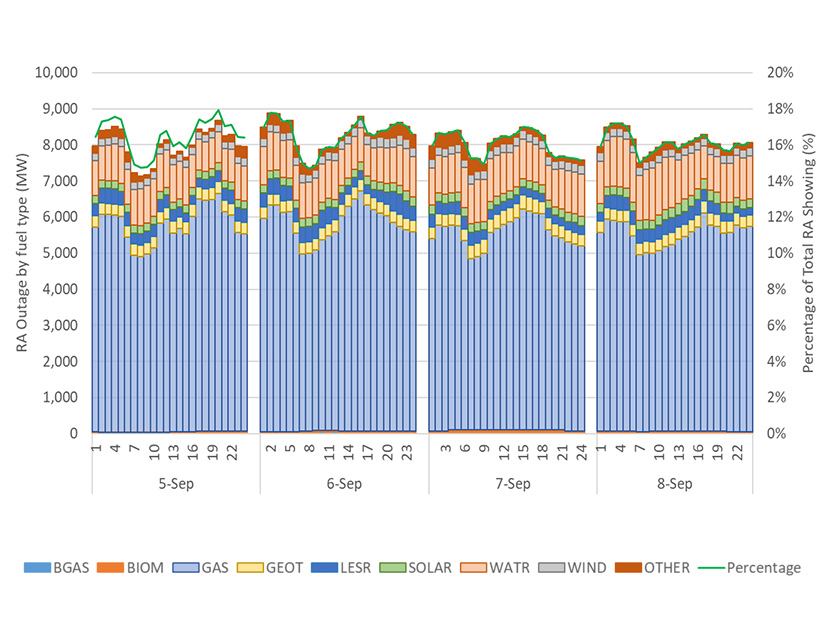CAISO staff and stakeholders are looking to re-evaluate the ISO’s Resource Adequacy Availability Incentive Mechanism (RAAIM) and explore whether it should be replaced with a new program relying on an unforced capacity (UCAP) construct to ensure sufficient RA capacity.
Moderating a Jan. 16 meeting of the ISO’s Resource Adequacy Design and Modeling Working Group, Jeff McDonald, vice president at Concentric Energy Advisors, said the potential ineffectiveness of RAAIM was a prominent topic in past RA meetings of the group and in submitted comments.
A UCAP construct, which seeks to procure the most reliable resources by factoring their historical lack of availability into their capacity value, has been offered as an alternative to RAAIM, although stakeholders questioned if the two programs were similar enough to replace one another or if they could operate in tandem.
“My view is that these two issues can be conceptually separated,” said Alva Svoboda, principal of market design integration at Pacific Gas and Electric. “RAAIM is an issue of how one deals with failures operationally to deliver what has been promised and UCAP can be considered simply as an improved approach to calculating what resources should be eligible to contribute in the RA plan.”
Implemented in 2016, RAAIM is a bid-based mechanism designed to incentivize resources providing RA capacity to meet their must-offer obligations (MOO) and provide substitute capacity should they go on forced outage. Resources are penalized for not meeting their MOO and rewarded when they do.
Stakeholders raised concerns about RAAIM shortly after its implementation. In January 2018, CAISO submitted a tariff amendment to FERC requesting modification of the program after identifying a series of issues and problematic outcomes related to it. The ISO found the methodology overweighted the availability of flexible RA capacity compared with generic RA because it treated each availability assessment hour (AAH) as equal, despite differences in RA types.
The ISO also found that RAAIM was designed in such a way that resources could be led to designate a minimal flex RA megawatt amount with a maximum hourly amount to minimize penalties, reducing incentives to provide capacity at other times. As a result, staff modified the program to treat each megawatt equally within each AAH and to evaluate generic and flex RA separately, among other modifications.
While FERC approved the modifications, stakeholders still raised concerns about the effectiveness of RAAIM and whether it could be replaced with UCAP.
RAAIM, UCAP — or Both?
At the Jan. 16 meeting, Lauren Carr, senior market policy analyst at CalCCA, disagreed with Svoboda that the two programs were conceptually distinct.
“If we have UCAP in place, it is a replacement for RAAIM, and it wouldn’t make sense to have both,” Carr said. “The purpose of RAAIM is to incent substitution when resources aren’t available to follow their must-offer obligation, and if you’re accounting for forced outages up front through UCAP, it wouldn’t make sense to have substitution rules for forced outages.”
Doug Boccignone, a principal at Flynn Resource Consultants, added that he thought RAAIM was redundant and feared having both programs could lead to double counting of resource contributions for both awards and penalties.
“I’m questioning whether you’d need additional incentives beyond the long-term UCAP incentive and the short-term incentive to bid your resources and get compensated for them in the market,” Boccignone said. “If you are taking into account reasonable expectation for the resource … you’ve already taken into account forced outages. And if a unit goes on outage, it would be a double penalty to make them go get replacement capacity for that resource you were [already] counting.”
Svoboda disagreed, saying that having both programs would not lead to double counting because they operate under different time frames and decision processes.
“The risk of double payment or over-penalizing is better addressed by getting the prices right and requirements right than by throwing the sticks on the table and trying to redesign from scratch,” he said.
But meeting participants largely agreed that the ISO should reevaluate RAAIM before deciding about UCAP.
“I think the re-evaluation of RAAIM is one of those low-hanging fruits that will be easy for the ISO to potentially change some of the layouts of the RA construct and the incentivization to show resources,” Nick Burki, senior integrated resource planner with City of Anaheim Public Utilities, said.
The RA Working Group’s next meeting is set for Feb. 13.


